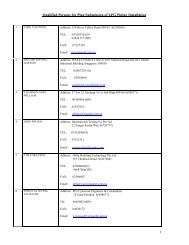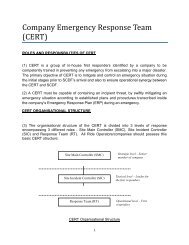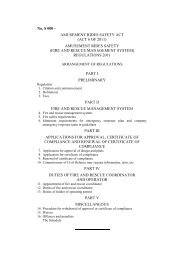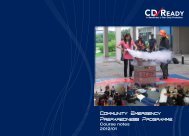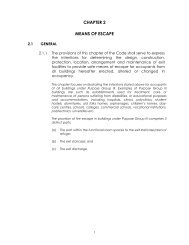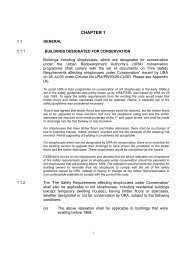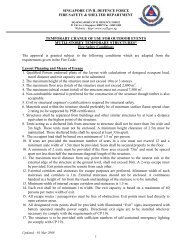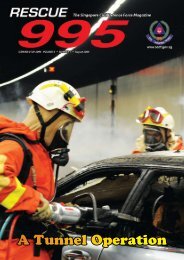Standard for Fire Safety in Rapid Transit Systems - Singapore Civil ...
Standard for Fire Safety in Rapid Transit Systems - Singapore Civil ...
Standard for Fire Safety in Rapid Transit Systems - Singapore Civil ...
Create successful ePaper yourself
Turn your PDF publications into a flip-book with our unique Google optimized e-Paper software.
A.1.7 Where tra<strong>in</strong>s arrive at a plat<strong>for</strong>m from only one direction, the<br />
“calculated tra<strong>in</strong> load” as used <strong>for</strong> exit calculations is<br />
calculated from the peak m<strong>in</strong>ute l<strong>in</strong>k load by multiply<strong>in</strong>g by<br />
two times the headway to allow <strong>for</strong> one missed headway. The<br />
maximum <strong>for</strong> the “calculated tra<strong>in</strong> load” should be the tra<strong>in</strong><br />
crush load.<br />
A.1.8 Where tra<strong>in</strong>s arrive at a plat<strong>for</strong>m from more than one<br />
direction, the entra<strong>in</strong><strong>in</strong>g load and calculated tra<strong>in</strong> load <strong>for</strong> the<br />
peak direction are computed as described above. In the offpeak<br />
direction, the entra<strong>in</strong><strong>in</strong>g load and calculated tra<strong>in</strong> load are<br />
computed from the peak m<strong>in</strong>ute entra<strong>in</strong><strong>in</strong>g load and the peak<br />
m<strong>in</strong>ute l<strong>in</strong>k load respectively, by multiply<strong>in</strong>g the headway.<br />
A.2 SINGLE SERVICE PLATFORMS<br />
A.2.1 Tables A and B illustrate the methodology <strong>for</strong> calculat<strong>in</strong>g the<br />
occupant load at a s<strong>in</strong>gle service side plat<strong>for</strong>m and centre<br />
plat<strong>for</strong>m respectively. The calculations are described <strong>in</strong> A.2.2<br />
and A.2.3 below.<br />
A.2.2 For a s<strong>in</strong>gle service side plat<strong>for</strong>m, as shown <strong>in</strong> Table A,<br />
(a) The calculated tra<strong>in</strong> load is determ<strong>in</strong>ed <strong>for</strong> each of the<br />
side plat<strong>for</strong>m <strong>for</strong> both the a.m. and the p.m. peak<br />
periods accord<strong>in</strong>g to the <strong>for</strong>mula:<br />
[ Peak hour l<strong>in</strong>k load ÷ 60 x surge factor x tra<strong>in</strong><br />
headway x 2 ], and<br />
(b) The maximum <strong>for</strong> the calculated tra<strong>in</strong> load shall be the<br />
tra<strong>in</strong> crush load, and<br />
(c) The entra<strong>in</strong><strong>in</strong>g load is determ<strong>in</strong>ed <strong>for</strong> each of the side<br />
plat<strong>for</strong>m <strong>for</strong> both the a.m. and the p.m. peak periods<br />
accord<strong>in</strong>g to the <strong>for</strong>mula:<br />
[ Peak hour entra<strong>in</strong><strong>in</strong>g figure ÷ 60 x surge factor x tra<strong>in</strong><br />
headway x 2 ], and<br />
(d) The calculated plat<strong>for</strong>m occupant load <strong>for</strong> each of the<br />
side plat<strong>for</strong>m <strong>for</strong> both the a.m. and the p.m. peak<br />
periods is the sum of calculated tra<strong>in</strong> load and<br />
entra<strong>in</strong><strong>in</strong>g load, and<br />
(e) The calculated plat<strong>for</strong>m occupant loads <strong>for</strong> each of the<br />
side plat<strong>for</strong>m <strong>for</strong> both the a.m. and the p.m. peak<br />
periods are compared to determ<strong>in</strong>e the maximum<br />
occupant load at each plat<strong>for</strong>m.<br />
S<strong>in</strong>gle service<br />
plat<strong>for</strong>m<br />
occupant load<br />
calculation<br />
<strong>Standard</strong> <strong>for</strong> <strong>Fire</strong> <strong>Safety</strong> <strong>in</strong> <strong>Rapid</strong> <strong>Transit</strong> <strong>Systems</strong> A-2



